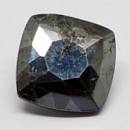|
|
||||||||||||||||
|
||||||||||||||||
|
||||||
|
|
|
|
Cylindrite
|
|
| | |
| Discovered in 1893; IMA status: Valid (pre-IMA; Grandfathered) | ||
|
| ||
|
Chemistry |
|
|
| |
|
Pb3Sn4FeSb2S14 | |
|
|
Lead Tin Iron Antimony Sufide |
|
Molecular Weight: |
1,844.71 gm |
|
Composition: |
Iron |
3.03 % |
Fe |
|
|
|
|
Tin |
25.74 % |
Sn |
|
|
|
|
Antimony |
13.20 % |
Sb |
|
|
|
|
Lead |
33.70 % |
Pb |
|
|
|
|
Sulfur |
24.34 % |
O |
|
|
|
|
|
100.00 % |
|
|
|
|
|
|
||||
|
Classification |
|
|
| |
|
Sulfides and Sulfosalts | |
|
2/C.17-0 | |
|
|
2 : SULFIDES and SULFOSALTS (sulfides, selenides,
tellurides; arsenides, antimonides, bismuthides; sulfarsenites,
sulfantimonites, sulfbismuthites, etc.) |
|
Related to: |
Cylindrite Group. |
|
Members of Group: |
Cylindrite Group: Abramovite, Cylindrite, Lévyclaudite |
|
Varieties: |
None |
|
Synonyms: |
Kylindrite |
|
|
|
|
Crystal Data |
|
|
|
|
|
In concentric spherical or tubular shells and aggregates, with individual cylindrical crystals up to 5 mm across and 2–3 cm in length, rarely terminated; also massive. |
|
|
None |
|
|
|
|
|
Physical Properties |
|
|
|
|
|
Perfect on {100} |
|
|
Malleable; deforms rather than breaking apart |
|
|
Malleable |
|
|
2.5; Vickers: VHN100=54 - 93 kg/mm2 |
|
|
5.43 - 5.49 (g/cm3) |
|
|
None |
|
|
Not Radioactive |
|
|
|
|
|
Optical Properties |
|
|
|
|
|
Lead gray, grayish black. In reflected light, galena-white |
|
|
Opaque |
|
|
Metallic |
|
|
R1–R2: (400) 34.5–40.3, (420) 34.3–40.1, (440) 34.1–40.1, (460) 33.6–39.8, (480) 33.1–39.4, (500) 32.5–38.9, (520) 31.8–38.3, (540) 31.2–37.8, (560) 30.7–37.2, (580) 30.3–36.7, (600) 29.9–36.3, (620) 29.6–35.9, (640) 29.3–35.5, (660) 28.9–35.1, (680) 28.6–34.7, (700) 28.4–34.4 |
|
|
0.000 (opaque) |
|
|
n/a |
|
|
Extremely weak: parallel to elongation gray-white, perpendicular to the elongation, darker gray-white. Stronger in oil. |
|
|
Distinct; gray to pale yellowish or brownish gray |
|
|
|
|
|
Occurances |
|
|
|
|
|
Geological Setting: |
In tin-bearing hydrothermal veins. |
|
Common Associations: |
Franckeite, Stannite, Incaite, Potosiite, Teallite, Jamesonite, Boulangerite, Cassiterite, Galena, Pyrite, Sphalerite |
|
Common Impurities: |
Ag |
|
Type Locality: |
Santa Cruz Mine, Poopó town, Poopó Province, Oruro Department, Bolivia |
|
Year Discovered: |
1893 |
|
View mineral photos: | |
|
|
|
|
More Information |
|
|
|
|
|
| |
|
|
|
|
Cylindrite is named from the Greek word κύλιυδροσ (kylindros), meaning a roll, in allusion to the typical cylindrical form of the crystals. Cylindrite
distribution:
Bolivia, with fine examples from Poopó, in the
Santa Cruz (Type Locality) and Trinacria mines;
at the Porvenir and Maria Francisca mines, Huanuni;
from the Nueva Virginia vein, Colquechaca; and from
the Purisima vein, all in Oruro; also from Llallagua,
Potosí. In the Smirnovsk deposit, Transbaikalia,
Russia. |
|
|
We
have not photographed our Cylindrite
gems yet. Please
check back soon. |
